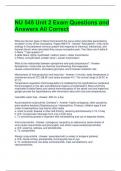NU 545 Unit 2 Exam Questions and
Answers All Correct
What are the two types of fibers that transmit the nerve action potentials generated by
excitation of any of the nociceptors. Pages 469-470 - Answer- Nociceptors = free nerve
endings in the peripheral nervous system that responds to chemical, mechanical, and
thermal stimuli; when stimulated they cause nociceptive pain. Two fibers are A-delta &
C fibers ***see question 7!
A-delta fibers: lightly myelinated, medium sized = faster transmission
C Fibers: unmyelinated, smaller sized = slower transmission
What is the relationship between epinephrine and body temperature? - Answer-
Epinephrine = body heat via chemical (nonshivering) thermogenesis
causes vasoconstriction, stimulates glycolysis, and increases metabolic rate
Mechanisms of heat production and heat loss - Answer- In human, body temperature is
maintained around 37C (98.6F) and rarely exceeds 41C. The normal range is 36.2C to
37.7C.
Temperature regulation (thermoregulation) is mediated by the hypothalamus; peripheral
thermoreceptors in the skin and abdominal organs (unmyelinated C fibers and thinly
myelinated A-delta fibers) and central thermoreceptors in the spinal cord and trigeminal
ganglia provide the hypothalamus with information about skin and core temperatures
insensible water loss - Answer- 600 mL a day
Acute bacterial conjunctivitis ("pinkeye") - Answer- highly contagious; often caused by
gram-positive bacteria (Staphylococcus, Haemophilus, Proteus); children ages 6 and
under à Haemophilus may lead to otitis media
a. onset is acute; disease is often self-limiting, resolving spontaneously in 10-14 day
b. S/S: mucopurulent drainage from one or both eyes
c. Tx: preventing spread of organism with handwashing and use of separate towels;
Viral conjunctivitis - Answer- contagious; caused by an adenovirus (some strains of
virus cause conjunctivitis and pharyngitis, and others cause keratoconjunctivitis)
a. S/S: watering, redness, and photophobia
b. Tx: symptomatic
Allergic conjunctivitis - Answer- associated with a variety of antigens (pollens)
a. S/S: Ocular itching, photophobia, burning/gritty feel in eye
b. Tx: antihistamines, low-dose corticosteroids, mast cell stabilizers, and
vasoconstrictors.
, Chronic conjunctivitis - Answer- result of any persistent conjunctivitis, and cause
requires identification for effective treatment.
Trachoma (chlamydial conjunctivitis) - Answer- caused by Chlamydia trachomatis, often
associated with poor hygiene and is the leading cause of preventable blindness in the
world
a. S/S: inflammation with scarring of the conjunctiva and eyelids à distorted lashes to
abrade the cornea à corneal scarring and blindness
b. Tx: surgery for in-turned lashes, systemic or local antibiotics, facial cleanliness, and
environmental improvement (WHO "SAFE" strategy for treatment)
Keratitis - Answer- inflammation of the cornea that can be noninfectious or caused by
bacteria, viruses, or fungi:
Bacterial infections à corneal ulceration; require intensive antibiotic treatment
(Staphylococcus aureus is the most common bacterial infection)
b. Virus (Type 1 herpes simplex) can involve the cornea and conjunctiva
c. Causes: contact use, trauma, and penetrating keratoplasty (corneal grafting)
which part of the brain controls pupillary changes. Pg. 508 - Answer- "Brainstem areas
that control arousal are adjacent to the areas that control the pupils. Eval of pupils can
give insight to brainstem dysfunction." (fig 17.2)
Characteristics of Alzheimer's disease - Answer- Progresses from mild short-term
memory deficits to total loss of cognition and executive functions. Can be misdiagnosed
easily in the early stage as forgetfulness or from an emotional cause
· Memory loss increases as progresses. Judgement and problem solving deteriorate
along with loss of mathematic calculation ability, language, and visuospatial orientation.
Mood changes common.
· Diagnosis by elimination, only made definitive in autopsy.
Review the anatomy of the brain. Which portion is responsible for keeping you awake,
controlling thought, speech, emotions and behavior, maintaining balance and posture? -
Answer- Broca Area in the inferior frontal lobe (Brodmann areas 44, 45) is an important
center for speech and language processing. This area, rostral to the inferior edge of the
premotor area (Brodmann area 6) o the inferior frontal gyrus, is usually most important
in the left hemisphere. Injury to this area results in difficulty forming or inability to for
words (expressive aphasia or dysphasia).
Know the function of the arachnoid villi. - Answer- The arachnoid villi protrude from the
arachnoid space, through the dura mater, and lie within the blood flow of the venous
sinuses. The villi function as one-way valves directing CSF outflow into the blood but
preventing blood flow into the subarachnoid space. Thus CSF is formed from the blood
and, after circulating throughout the CNS, it returns to the blood.




